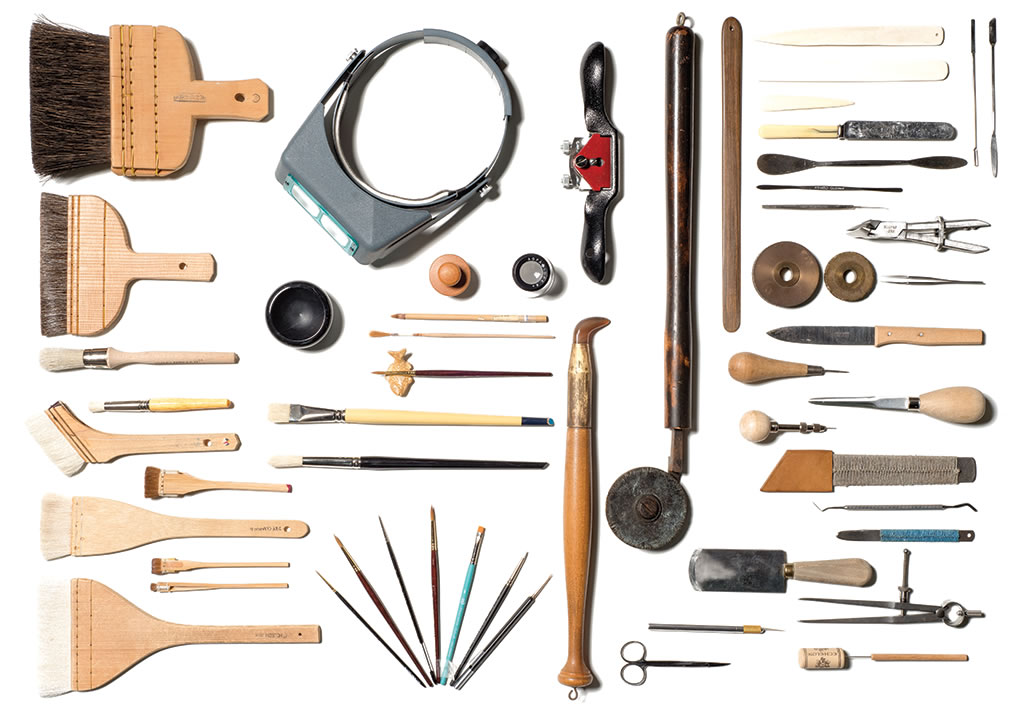Preservation and Conservation
Explore our work and help preserve a legacy.
Forever is a very long time. The Ransom Center's exceptional collections require ongoing preservation management to ensure that they remain available for study and enjoyment long into the future. The Center's Preservation and Conservation Division, comprised of a team of conservators and preservation technicians, has primary responsibility for policies and practices in the areas of preventive care, conservation treatment, research, and education.
Treatment of the Center's diverse holdings requires an in-depth understanding of many types of material, a broad range of scientific and technical skills, and, at times, the development of unique processes. Although each of the Center's five conservators and three technicians is skilled in a particular specialty such as book, paper, or photograph conservation, fabrication of special enclosures, integrated pest management, or monitoring of building environments, all are equally engaged with preservation, exhibition, storage, and access for the full range of objects in the collections.
Find out how to support the ongoing conservation and preservation efforts of the Center.
-
Prevention
The Preservation and Conservation Division manages a range of collections care operations targeted at optimizing and maintaining a sound, protective storage, and exhibition environment for the Ransom Center's collection. Preventing damage to and deterioration of collection materials is a first line defense that will enhance their longevity and accessibility. Programmatic operations include:
- Monitoring the building's environments, measuring light levels, temperature, and relative humidity throughout collection and exhibition spaces
- Inspecting all building environments regularly for pests and applying preventive and remedial solutions to ensure a pest-free environment
- Inspecting all new acquisitions immediately to ensure that insects and moldy materials do not enter building storage areas
- Providing a training program for all Center staff on the safe handling of collection materials, and creating didactic materials for visitors to the Reading Room who are consulting collection items
- Surveying collections to understand their condition and storage needs
- Designing and fabricating protective enclosures for the range of the Center's collection materials in order to protect them from handling damage and deteriorating factors such as light, dust, pollutants, and temperature and humidity fluctuations
- Maintaining an emergency response plan in the event that natural and human made disasters put the Center's collections at risk
-
Treatment
The vast range of items in the Center's collections are made up of organic and inorganic materials produced by an array of historical and modern technologies. The Center's five conservators are specialists in the care and treatment of books, paper, and photographs. They are educated in the longevity issues different organic and inorganic materials present and skilled in the scientific treatment and preservation of cultural records. They work closely with the Center's preservation technicians in the design of specialized enclosures and in the range of preventive care programs the Preservation and Conservation Division oversees.
The conservators are charged with implementing minimally invasive treatment techniques to chemically and physically stabilize the condition of collection items so that they can be safely stored, handled, exhibited, and loaned to other institutions for exhibition. Before treatment can happen, the conservators employ techniques and equipment that assist them in examining the condition and make-up of a particular collection item. They also work closely with the Center's curators to study, for example, the bibliographic, literary, and artistic processes and methods that help them determine the appropriate treatment for any collection item.
-
Education
Since it was established in 1980, the department has mentored interns from all over the world. Fostering preservation awareness and educational opportunities within the community at large remains a priority.

Contact
Preservation and Conservation Division
conservation@hrc.utexas.edu
512-471-9117

